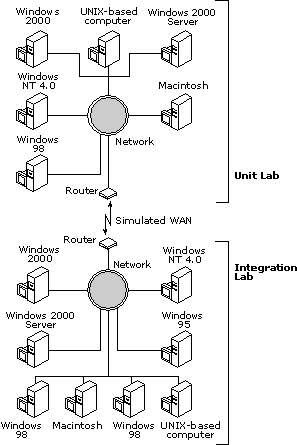Managing the Migration Process |
A working development environment allows for proper development and testing of the solution so that it has no negative impact on production systems. You’ll need to have sufficient development computers available for migrating and porting applications and for performing application-specific testing.
In addition, if your organization does not already have a suitable test lab in place, the team must build one. The test lab should contain servers that are representative of the new user environment. For example, if the new environment will be mixed, including computers that are running UNIX or Macintosh® operating systems along with computers that are running Windows 2000 Server, the test lab should reflect this.
The test lab consists of a unit lab and an integration lab. The unit lab is used for the initial preliminary evaluation and review of features, functions, and application software behavior. After applications are ported or developed, and then are evaluated on the development computer, they are tested in the unit lab.
Once applications are tested and approved at the unit lab, they are staged in the integration lab, so that users and other assigned teams can begin the evaluation process.
The integration lab should be made available for other project teams and users at different times during deployment. This gives design and testing teams an opportunity to review and address any immediate problems or issues found, without taking much time away from their overall project responsibilities.
The unit and integration lab environments should be identical in order to support evaluation of cross-router and cross-bridge connectivity. Two routers can divide the labs to simulate a wide area network (WAN). This way, design and testing teams can replicate production environments throughout the enterprise and eliminate potential problems during the testing process.
Depending on your user environment, each lab might be a pure Windows 2000 environment, or it might include both Windows 2000 and another network operating system. Desktop operating systems could include Microsoft® Windows® 95, Microsoft® Windows NT® 3.51 or Microsoft® Windows NT® 4.0, Windows 2000, Macintosh, and even some UNIX-based computers. Be sure to make each environment identical to the desktop configuration when Windows 2000 Server is deployed.
The following figure shows a unit and integration lab with a WAN link simulated by using two routers.
